Woods Walker
The Wood is cut, The Bacon is cooked, Now it’s tim
I have tested both the updated EOS and EOS II headlamps. Years ago I tested out an EOS but despite liking the physical characteristics I found the light lacking the necessary flood output for my usage so it was rejected. However this update addresses the deficiencies of the old EOS and keeps everything I liked. Both headlamps have regulated output. This means that the initial brightness remains unchanged for a portion of the total runtime with reducing brightness after the headlamp falls out of regulation. This allows the user a fair warning to change the batteries. The updated EOS headlamps are now my favorite within the 3xAAA form factor.
4-Mode EOS Rebel:
http://www.princetontec.com/?q=node/65
The 4-mode EOS has a low, medium, high and a flashing mode. PT has the following ratings for each mode.
1. Low mode total burn time 121 hours with 50 hours regulated. 16m throw during regulation
2. Medium mode burn time 115 hours with 10 hours regulated. 32m throw during regulation.
3. High mode burn time 113 hours with 1 hour regulated. 54m throw during regulation.
The newer headlamp has the 50 lumen rating right on the package. Both the EOS and EOS II are physically similar. The PT marketing department has decided to finally give the type of LED in addition to "Maxbright". The Rebel 4-mode EOS is priced between 34-43 dollars
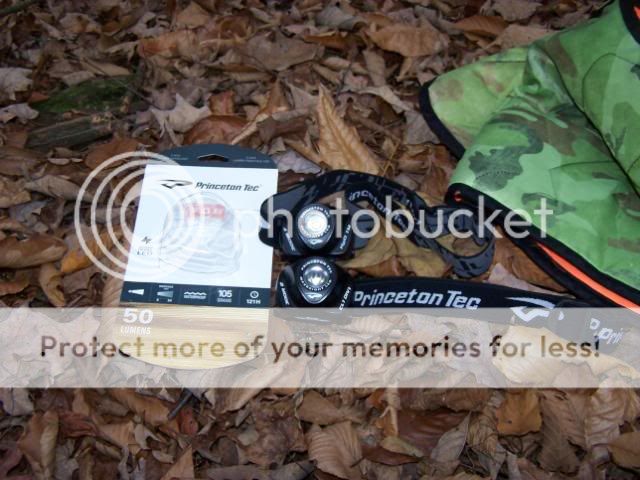
Both updated headlamps have the same frosted optic. The older EOS has a clear optic. Here is a close up of the EOS frosted Optic.
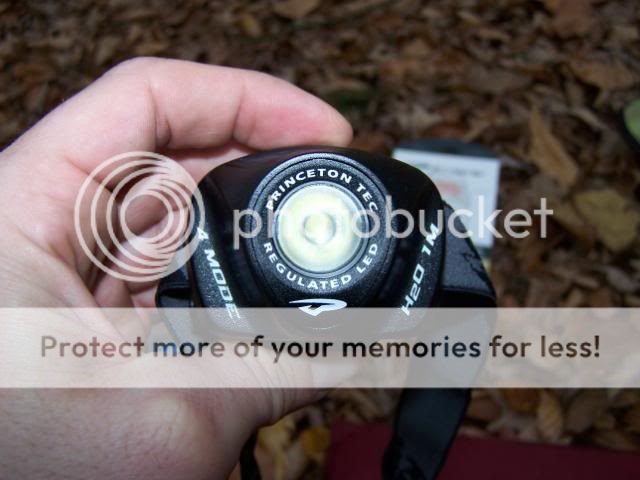
Both headlamps have the same battery installation. Just unscrew the nut on the back and 3xAAA batteries go into their clearly marked slots. I found battery installation on the EOS line to be far easier than my Tikka Plus or PT Aurora. Water resistance is achieved via O-ring. The headlamps are rated for Alkaline, Lithium and NIMH rechargeable. I run them both with 900 mAh Energizer NiMH and Duracell 800 mAh LSD NiMH batteries. Alkaline batteries are cheap and offer reasonable performance on the low modes but in my view suffer on high and sometimes leak. The NiMH batteries seem to offer better performance than Alkaline. Lithiums work great in the cold. I have not tested the EOS with Lithiums however if conventional wisdom holds I would expect longer regulated runtimes on Hi and standard performance on low. For longer term storage I use the LSD NiMH batteries as they will not self discharge over time and will not leak. My backup batteries are standard NiMH. These are topped off every month or so if not used. But they always seem to get used for weekend camping trips. Keep in mind that I am no expert on batteries and all of the above is based on field testing and educated guesses.
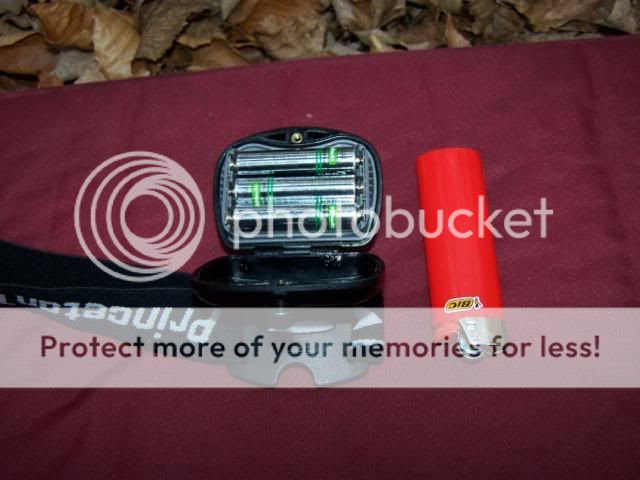
Both headlamps are comfortable over extended usage. I found that the EOS was a bit bulkier than my other headlamps within this class. But not overly so. Here is a comparison photo for the EOS II, EOS, PT Aurora and Tikka Plus headlamps.
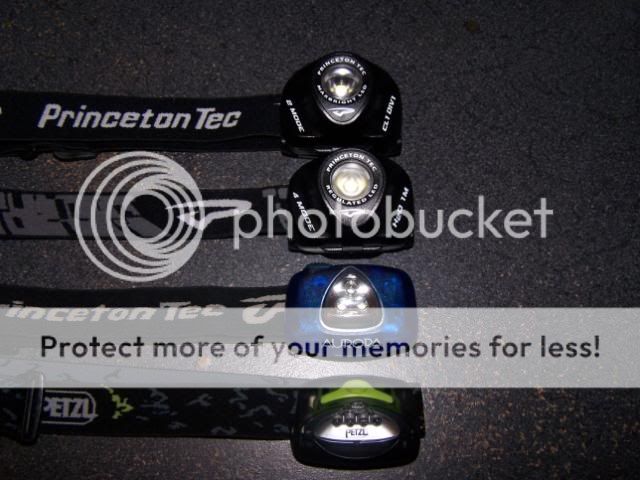
The UI is fairly simple. The user can click though all modes. However if the user clicks though all four modes the headlamp will turn off. Also if the user waits for more than a few seconds to change the modes the headlamp will turn off. This is not that unusual. The headlamp starts off on high than moves to medium-low and ends with flashing mode.
Field testing:
For reasons that are unclear to me I found the 4-mode EOS to be brighter than the 2-mode industrial work light. The EOS II is a sold 50 lumens however I find it hard to believe that the 4-mode EOS isn't more than the listed 50 lumens. The optic was a bit more frosted. This could be intentional however don't know for certain. At first I felt the greater flood provided by the slightly more frosted optic would come at the expense of throw however both lights had equal throw (distance) but the 4-Mode EOS has greater flood. It really lights up the woods on high. I also found the 4-mode EOS has a warmer tint. I don't know if this greater output is because of the variations between LEDS or if they used a different Rebel. Being no expert on LEDs I can't say but this difference would only be noticed if some had both headlamps running at the same time like me during a test. Overall the 4-mode Rebel EOS has a very good balance between flood and throw. A near perfect beam for trail work.
I don't have any way to test the exact lumen rating so keep in mind that these ratings are based on comparisons with flashlights of known lumen ratings. On Hi the headlamp seemed like 50 plus lumens out front. It illuminated a good area and trail markers at some distance. It seemed to maintain the 50 plus lumen rating for longer than the listed 1 hour but it is hard to tell with the naked eye. On medium it seemed like about 25 lumens. I found the medium setting well within my comfort zone for both known trails and bushwhacking. I have not tested the full 10 hour regulated output at one time but feel I could hike all night on full regulation based on my overnight camping/hiking test. The low setting matched my E01 per my eye so guessing it is 6ish lumens. Great for camp work and a short walk to answer natures call however it was below my comfort level for night hikes. I didn't test the 50 hour low regulated output but see no reason not to trust PT on their ratings. The UL was easy to use but I didn't care for the flashing mode and wished the UI was more like the EOS II. After a few seconds the UI would reset to next click = off so I would have to restart the cycle to change modes. The EOS II could switch between modes without the light turning off after the mode is left on for an extended time. All that being said the UL of the 4-mode EOS is familiar to me. I just wish both headlamps would start on low rather than high.
The Rebel EOS II industrial work headlamp.
http://www.princetontec.com/?q=node/118
Both headlamps share many of the same characteristic so I will try and not repeat the same information for this review. The differences between the EOS/EOS II are within the UI. PT does mention something about chemical resistance plastic of the EOS II however I am betting that both headlamps are made out of the same stuff. The EOS II does come with a rubber strap in addition to the stretch cloth for attachment to a hard hat. The EOS II is a two mode light. Just high or low. The user can switch between modes by simply pressing the recessed button. The switch on both headlamps is a bit stiff but this is not a problem as it helps reduce accidental activation within someone's pack.
PT lists the ratings as the following:
1. High is 50 lumens with no throw rating.
2. Low is not listed.
The spotty listing is due to the packaging of the EOS II. Being an industrial work headlamp the packaging consists of a box with just the light and extra rubber strap in plastic wrap. No instructions are provided. But though testing I have found the high rating is a true solid 50 lumens with a longer than listed regulated runtime. Maybe two plus hours rather than the 1-1.5 of the 4-Mode EOS however this is just a guess based on my naked eye and maybe proven un true if anyone ever does a scientific test. I see no reason not to think the total runtime isn't near the 120ish hours of the 4-mode EOS. The low setting seemed like 10ish lumens. My test showed a regulated runtime of around 13-14 hours based on timed hikes/camping usage but again I could be wrong. I think maybe the total runtime would be between the medium and low modes on the 4-mode EOS. So guessing the runtime on low is 13 hours regulated with a total 114 hours.
Field testing:
The high worked great for bushwhacking and hard trail work. But it was a bit less in terms of flood than the 4-mode EOS with equal throw. I found the tint warmer than most of my headlamps but the 4-mode EOS has a better tint and overall nicer beam. However these differences can only be discerned if someone has both headlamps side by side and may be due to the variations within LEDS. They don't call it a lottery for no reason. In any case the EOS II for the most part like the 4-mode EOS has a good balance of flood and throw. The low setting is between the 4-mode EOS low and medium. It was just below my comfort level for night hikes. However it is very doable for familiar trails and workable for bushwhacking if looking to conserve on battery power. But during a test on an untraveled trail there were times I had to move up to high. The UI is my favorite of the two headlamps. Two modes and the light does not turn off between switching even if the mode is left on for a longer period. To turn the headlamp off I just hold the button down. Overall this was a joy but the lack of a medium mode was a real downer.
Beam shots:
Here is a beam shot of both headlamps on high including my Tikka plus for scale. The EOS II is on the far left, the 4-mode EOS in the middle and Tikka plus on the far right.
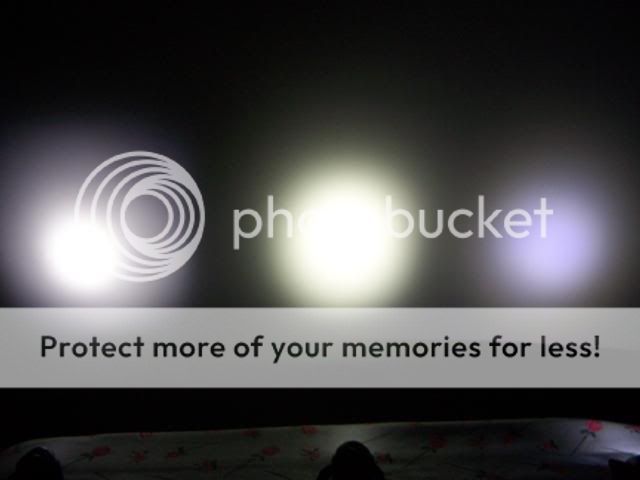
It appears to me that the 4-mode EOS is both brighter and warmer than the 2-mode EOS work headlamp. The beam is near perfect. But despite the photos the EOS II is warmer than the Tikka plus and far less blue than my older PT Apex and Aurora 5mm LEDs. But the beam of the 4-Mode EOS is just darn right sweet however there is no guarantee that all EOS headlamps will reflect this.
A beam shot of the 2-mode EOS II high compared to the 4-mode EOS low.
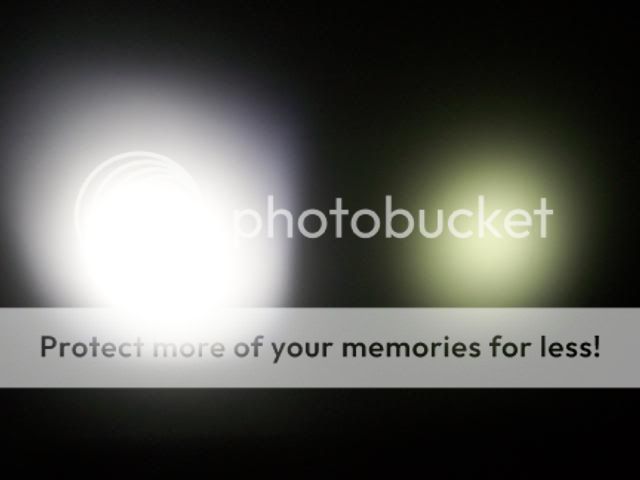
The 4-mode EOS low is nice and low just like it should be.
A beam shot of the 2-mode EOS II low compared to the 4-Mode EOS high.
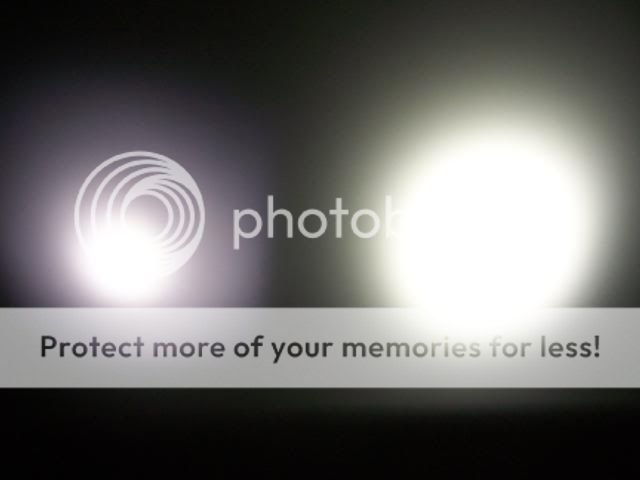
The EOS II low is between the 4-mode EOS low and medium.
Conclusion:
I think the newer updated EOS headlamps are very nice. They are my current favorite headlamps within this class. The light output is very good for my field use. Considering that most headlamps are used for extended periods of time PT showed a very good understanding of just what makes a great headlamp. The output, beam and tint all work together. Overall I prefer the 4-mode EOS as the one I own is brighter and has a better beam and tint. Also it is cheaper and more readily available. I hope this review was useful.
4-Mode EOS Rebel:
http://www.princetontec.com/?q=node/65
The 4-mode EOS has a low, medium, high and a flashing mode. PT has the following ratings for each mode.
1. Low mode total burn time 121 hours with 50 hours regulated. 16m throw during regulation
2. Medium mode burn time 115 hours with 10 hours regulated. 32m throw during regulation.
3. High mode burn time 113 hours with 1 hour regulated. 54m throw during regulation.
The newer headlamp has the 50 lumen rating right on the package. Both the EOS and EOS II are physically similar. The PT marketing department has decided to finally give the type of LED in addition to "Maxbright". The Rebel 4-mode EOS is priced between 34-43 dollars

Both updated headlamps have the same frosted optic. The older EOS has a clear optic. Here is a close up of the EOS frosted Optic.

Both headlamps have the same battery installation. Just unscrew the nut on the back and 3xAAA batteries go into their clearly marked slots. I found battery installation on the EOS line to be far easier than my Tikka Plus or PT Aurora. Water resistance is achieved via O-ring. The headlamps are rated for Alkaline, Lithium and NIMH rechargeable. I run them both with 900 mAh Energizer NiMH and Duracell 800 mAh LSD NiMH batteries. Alkaline batteries are cheap and offer reasonable performance on the low modes but in my view suffer on high and sometimes leak. The NiMH batteries seem to offer better performance than Alkaline. Lithiums work great in the cold. I have not tested the EOS with Lithiums however if conventional wisdom holds I would expect longer regulated runtimes on Hi and standard performance on low. For longer term storage I use the LSD NiMH batteries as they will not self discharge over time and will not leak. My backup batteries are standard NiMH. These are topped off every month or so if not used. But they always seem to get used for weekend camping trips. Keep in mind that I am no expert on batteries and all of the above is based on field testing and educated guesses.

Both headlamps are comfortable over extended usage. I found that the EOS was a bit bulkier than my other headlamps within this class. But not overly so. Here is a comparison photo for the EOS II, EOS, PT Aurora and Tikka Plus headlamps.

The UI is fairly simple. The user can click though all modes. However if the user clicks though all four modes the headlamp will turn off. Also if the user waits for more than a few seconds to change the modes the headlamp will turn off. This is not that unusual. The headlamp starts off on high than moves to medium-low and ends with flashing mode.
Field testing:
For reasons that are unclear to me I found the 4-mode EOS to be brighter than the 2-mode industrial work light. The EOS II is a sold 50 lumens however I find it hard to believe that the 4-mode EOS isn't more than the listed 50 lumens. The optic was a bit more frosted. This could be intentional however don't know for certain. At first I felt the greater flood provided by the slightly more frosted optic would come at the expense of throw however both lights had equal throw (distance) but the 4-Mode EOS has greater flood. It really lights up the woods on high. I also found the 4-mode EOS has a warmer tint. I don't know if this greater output is because of the variations between LEDS or if they used a different Rebel. Being no expert on LEDs I can't say but this difference would only be noticed if some had both headlamps running at the same time like me during a test. Overall the 4-mode Rebel EOS has a very good balance between flood and throw. A near perfect beam for trail work.
I don't have any way to test the exact lumen rating so keep in mind that these ratings are based on comparisons with flashlights of known lumen ratings. On Hi the headlamp seemed like 50 plus lumens out front. It illuminated a good area and trail markers at some distance. It seemed to maintain the 50 plus lumen rating for longer than the listed 1 hour but it is hard to tell with the naked eye. On medium it seemed like about 25 lumens. I found the medium setting well within my comfort zone for both known trails and bushwhacking. I have not tested the full 10 hour regulated output at one time but feel I could hike all night on full regulation based on my overnight camping/hiking test. The low setting matched my E01 per my eye so guessing it is 6ish lumens. Great for camp work and a short walk to answer natures call however it was below my comfort level for night hikes. I didn't test the 50 hour low regulated output but see no reason not to trust PT on their ratings. The UL was easy to use but I didn't care for the flashing mode and wished the UI was more like the EOS II. After a few seconds the UI would reset to next click = off so I would have to restart the cycle to change modes. The EOS II could switch between modes without the light turning off after the mode is left on for an extended time. All that being said the UL of the 4-mode EOS is familiar to me. I just wish both headlamps would start on low rather than high.
The Rebel EOS II industrial work headlamp.
http://www.princetontec.com/?q=node/118
Both headlamps share many of the same characteristic so I will try and not repeat the same information for this review. The differences between the EOS/EOS II are within the UI. PT does mention something about chemical resistance plastic of the EOS II however I am betting that both headlamps are made out of the same stuff. The EOS II does come with a rubber strap in addition to the stretch cloth for attachment to a hard hat. The EOS II is a two mode light. Just high or low. The user can switch between modes by simply pressing the recessed button. The switch on both headlamps is a bit stiff but this is not a problem as it helps reduce accidental activation within someone's pack.
PT lists the ratings as the following:
1. High is 50 lumens with no throw rating.
2. Low is not listed.
The spotty listing is due to the packaging of the EOS II. Being an industrial work headlamp the packaging consists of a box with just the light and extra rubber strap in plastic wrap. No instructions are provided. But though testing I have found the high rating is a true solid 50 lumens with a longer than listed regulated runtime. Maybe two plus hours rather than the 1-1.5 of the 4-Mode EOS however this is just a guess based on my naked eye and maybe proven un true if anyone ever does a scientific test. I see no reason not to think the total runtime isn't near the 120ish hours of the 4-mode EOS. The low setting seemed like 10ish lumens. My test showed a regulated runtime of around 13-14 hours based on timed hikes/camping usage but again I could be wrong. I think maybe the total runtime would be between the medium and low modes on the 4-mode EOS. So guessing the runtime on low is 13 hours regulated with a total 114 hours.
Field testing:
The high worked great for bushwhacking and hard trail work. But it was a bit less in terms of flood than the 4-mode EOS with equal throw. I found the tint warmer than most of my headlamps but the 4-mode EOS has a better tint and overall nicer beam. However these differences can only be discerned if someone has both headlamps side by side and may be due to the variations within LEDS. They don't call it a lottery for no reason. In any case the EOS II for the most part like the 4-mode EOS has a good balance of flood and throw. The low setting is between the 4-mode EOS low and medium. It was just below my comfort level for night hikes. However it is very doable for familiar trails and workable for bushwhacking if looking to conserve on battery power. But during a test on an untraveled trail there were times I had to move up to high. The UI is my favorite of the two headlamps. Two modes and the light does not turn off between switching even if the mode is left on for a longer period. To turn the headlamp off I just hold the button down. Overall this was a joy but the lack of a medium mode was a real downer.
Beam shots:
Here is a beam shot of both headlamps on high including my Tikka plus for scale. The EOS II is on the far left, the 4-mode EOS in the middle and Tikka plus on the far right.

It appears to me that the 4-mode EOS is both brighter and warmer than the 2-mode EOS work headlamp. The beam is near perfect. But despite the photos the EOS II is warmer than the Tikka plus and far less blue than my older PT Apex and Aurora 5mm LEDs. But the beam of the 4-Mode EOS is just darn right sweet however there is no guarantee that all EOS headlamps will reflect this.
A beam shot of the 2-mode EOS II high compared to the 4-mode EOS low.

The 4-mode EOS low is nice and low just like it should be.
A beam shot of the 2-mode EOS II low compared to the 4-Mode EOS high.

The EOS II low is between the 4-mode EOS low and medium.
Conclusion:
I think the newer updated EOS headlamps are very nice. They are my current favorite headlamps within this class. The light output is very good for my field use. Considering that most headlamps are used for extended periods of time PT showed a very good understanding of just what makes a great headlamp. The output, beam and tint all work together. Overall I prefer the 4-mode EOS as the one I own is brighter and has a better beam and tint. Also it is cheaper and more readily available. I hope this review was useful.
Last edited:


